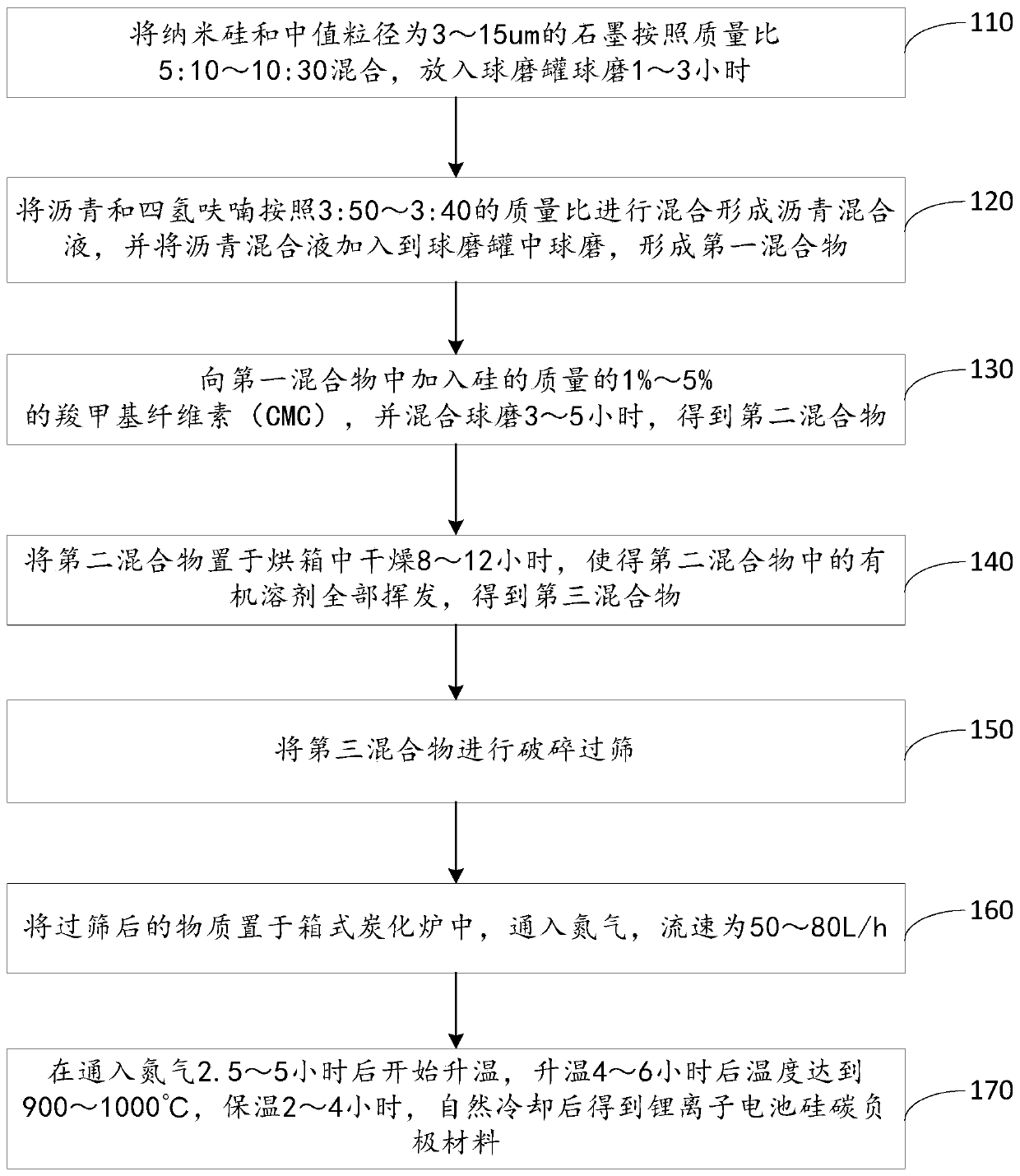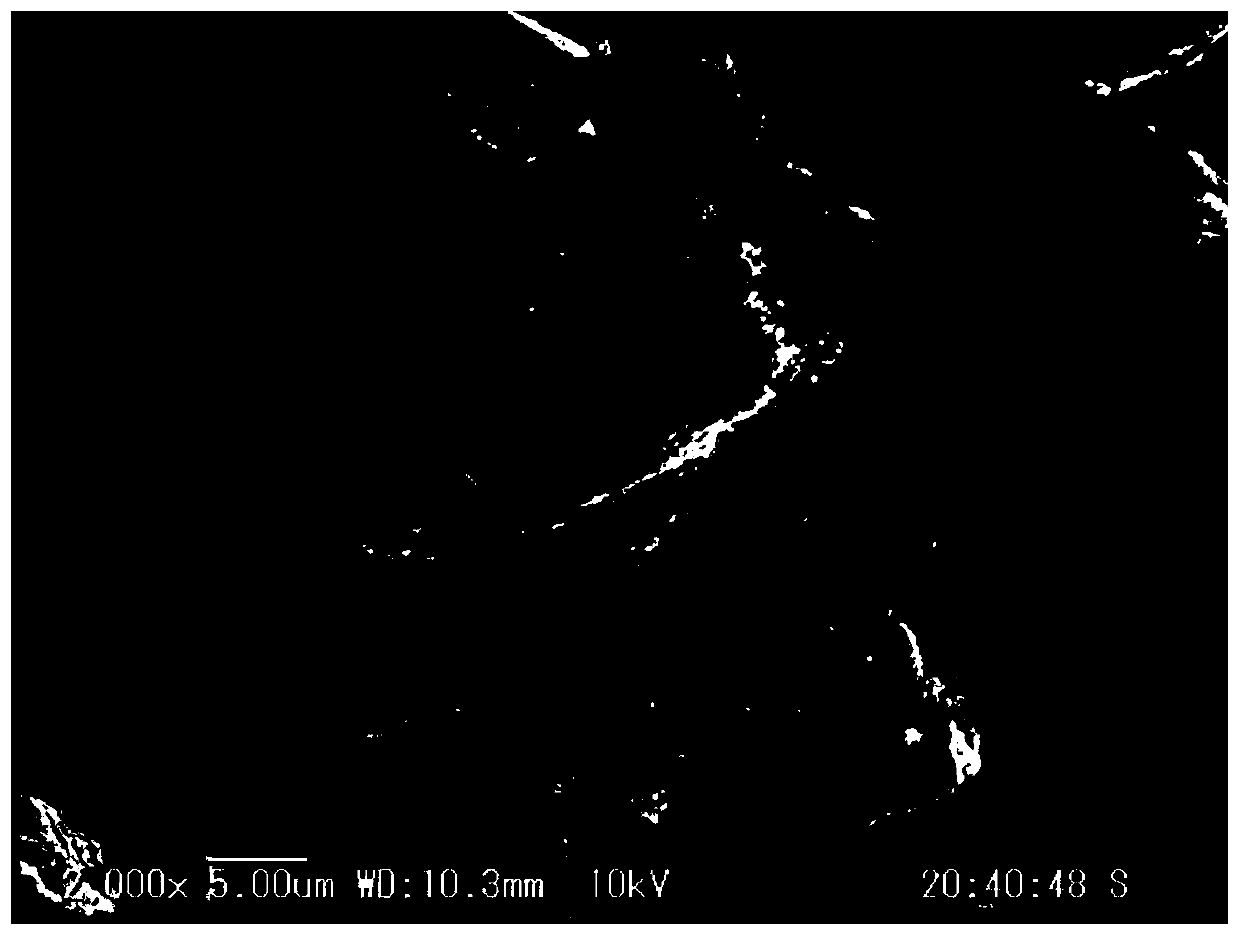Lithium battery silicon-carbon negative electrode material, negative electrode material and lithium battery
A negative electrode material, lithium battery technology, applied in battery electrodes, nanotechnology for materials and surface science, secondary batteries, etc., can solve the problems of poor cycle performance and low first effect, achieve high gram capacity and improve performance , the effect of high first-week efficiency
- Summary
- Abstract
- Description
- Claims
- Application Information
AI Technical Summary
Problems solved by technology
Method used
Image
Examples
Embodiment 1
[0044] This embodiment provides a method for preparing a silicon-carbon negative electrode material for a lithium-ion battery, which specifically includes the following steps:
[0045] A: Weigh 5g of nano-silicon with a median particle size of 100nm, place 10g of artificial graphite in a 500mL beaker, stir and mix for 10min, and place the mixture in a ball mill tank for 2 hours at a speed of 300r / min;
[0046] B: Add 1.5g of asphalt to 25g of tetrahydrofuran and mix;
[0047] C: Add the mixed solution obtained in step B to the ball mill tank in step A;
[0048] D: Add 0.05 g of CMC to the mixture obtained in step C, and ball mill the mixture for 3 hours;
[0049] E: Dry the mixture in step D in an oven with a temperature of 80°C for 12 hours, and dry until all the organic solvents are volatilized;
[0050] F: The mixture obtained in step E is crushed and passed through a 300-mesh sieve;
[0051] G: Put the mixture obtained in step F in a box-type carbonization furnace, use ...
Embodiment 2
[0057] This embodiment provides a method for preparing a silicon-carbon negative electrode material for a lithium-ion battery, which specifically includes the following steps:
[0058] A: Weigh 5g of nano-silicon with a median particle size of 100nm, place 10g of natural graphite in a 500mL beaker, stir and mix for 10min, and place the mixture in a ball mill jar for ball milling for 2 hours at a speed of 300r / min;
[0059] B: Add 1.5g asphalt to 25g tetrahydrofuran and mix;
[0060] C: Add the mixed solution obtained in step B to the ball mill tank in step A;
[0061] D: Add 0.05 g of CMC to the mixture obtained in step C, and ball mill the mixture for 3 hours;
[0062] E: Dry the mixture obtained in step D in an oven at a temperature of 70°C for 12 hours, and dry until all the organic solvents are volatilized;
[0063] F: The mixture obtained in step E is crushed and passed through a 300-mesh sieve;
[0064] G: Put the mixture obtained in step F in a box-type carbonization...
Embodiment 3
[0067] This embodiment provides a method for preparing a silicon-carbon negative electrode material for a lithium-ion battery, which specifically includes the following steps:
[0068] A: Weigh 5g of nano-silicon with a median particle size of 30nm, place 10g of artificial graphite in a 500mL beaker, stir and mix for 10min, and place the mixture in a ball mill jar and ball mill for 2 hours at a speed of 300r / min;
[0069] B: Add 1.5g of asphalt to 25g of tetrahydrofuran and mix;
[0070] C: Add the mixed solution obtained in step B to the ball mill tank in step A;
[0071] D: Add 0.05 g of CMC to the mixture obtained in step C, and ball mill the mixture for 3 hours;
[0072] E: Dry the mixture obtained in step D in an oven with a temperature of 80° C. for 12 hours, and dry until all the organic solvents are volatilized;
[0073] F: The mixture obtained in step E is crushed and passed through a 300-mesh sieve;
[0074] G: Put the mixture obtained in step F in a box-type carb...
PUM
 Login to View More
Login to View More Abstract
Description
Claims
Application Information
 Login to View More
Login to View More - R&D
- Intellectual Property
- Life Sciences
- Materials
- Tech Scout
- Unparalleled Data Quality
- Higher Quality Content
- 60% Fewer Hallucinations
Browse by: Latest US Patents, China's latest patents, Technical Efficacy Thesaurus, Application Domain, Technology Topic, Popular Technical Reports.
© 2025 PatSnap. All rights reserved.Legal|Privacy policy|Modern Slavery Act Transparency Statement|Sitemap|About US| Contact US: help@patsnap.com



